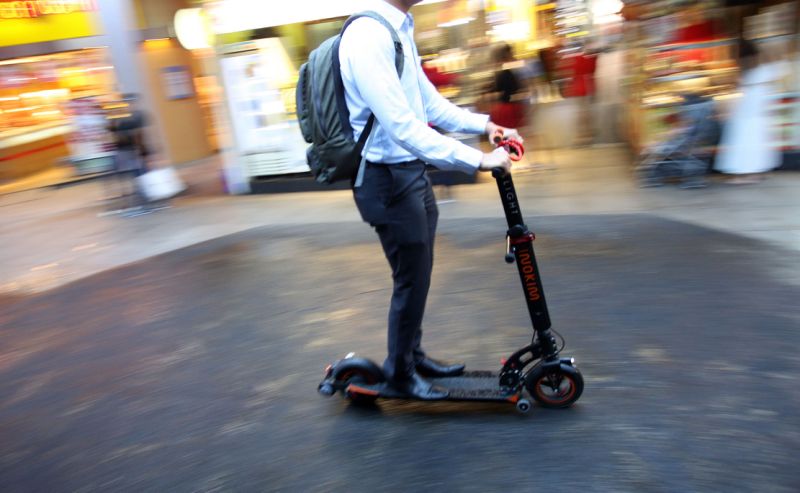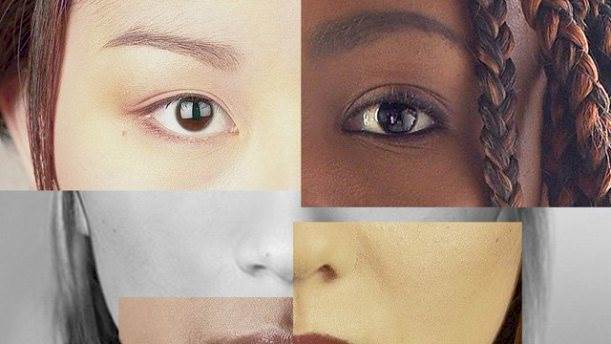Remember when we used to have Ofo and Obikes?
They were such a blessing and provided so much convenience, until we killed them off. Sadly, Singaporeans were just not gracious and civil enough to look after these nice things.
When shared bikes exited Singapore, PMDs took over. It was a great mobility device for its ease of access and price point. You didn’t have to go through the lengthy and expensive procedure of getting a vehicle (and license), and these devices were a great step up from bicycles.
When PMDs became more popular in our society, problems began to arise.
On the ground level, you have the groups of Young Punks that zip around on their modded e-scooters or e-bikes, like they are the kings of the road. Modern day romance for the younger generation now includes standing in tandem on a speeding e-scooter with chroma lights and raucous music to boot. And if you have ever stood in the way of one of these YPs, you will understand what it's like to be assaulted by the blaring music that almost seems to scream at you to “SIAM LAH”.
PMD riders may also be overzealous to trust in their ability to have full control of their devices and in preventing collisions, because the thing about accidents is that you never really know when an accident will happen. What's more, when many pedestrians are like digital zombies with their phones.
PMDs had become increasingly problematic as they fall between the cracks—they don’t belong on the roads as it is too dangerous for motorists and PMD riders, but they don’t really belong on the footpaths either because of the potential severity it can cause due to its speed and weight.
Furthermore, with the increasing number of accidents in the past year or so, the ban was something that has been brewing for a long time coming.
The Problem With The E-Scooter Ban
On the surface, it’s a relief that the ban wasn’t a complete one of all PMDs across Singapore. However, restricting e-scooters and e-bikes to cycling paths and park connector network is like removing toilet paper from toilets. Sure, one can still use their devices but it’s going to be very inconvenient.
E-scooters and e-bikes (or PABs) are banned from footpaths from 5 Nov
Image Credit: CNA
The biggest problem of all isn’t exactly the ban itself, but how it was introduced so suddenly.
The advisory period allows offenders a chance to be issued warnings before the penalties (fines and jail time) kick in next year, but the end message is still the same: E-scooter and e-bike users are not allowed on footpaths.
It has affected thousands of Singaporeans. Some of whom depended heavily on their PMDs for their livelihood. If my livelihood had been taken away overnight, I would be riled up too.
One day is hardly enough time for anyone to make alternative arrangements, especially for those who had been relying heavily on their devices for a livelihood. And it is for this reason that so food delivery riders have gone on to meet with some of our political leaders to seek help.
People were also upset because it seemed like there are alternatives that wasn’t explored before the ban kicked in. For example, could it not have been a more gradual transition? Why had the possibility of providing at least the food delivery riders the chance to be licensed to ride not been considered? And what about dedicated paths for PMDs?
Subsequently, LTA and the Ministry of Transport have launched an e-scooter Trade-in Grant (eTG) to provide comprehensive assistance to affected food delivery riders. Riders who wish to continue working for food delivery companies will receive $1,000 to switch to Power Assisted Bicycles (PABs) or $600 for bicycles.
Moving forward however, I highly doubt that the future for e-scooters will improve anytime soon. The issue is as with any new disruption. It requires the authorities to come up with new solutions to address the disruption. Any changes to reverse the ban or for e-scooters to be conditionally allowed ‘on the roads’ again is going to involve large-scale work.
Because We Took It For Granted
The ban wasn’t exactly a surprise either. The fact is that we just didn't know how to coexist on the same footpaths. Most of our footpaths is at a comfortable size to be shared with pedestrians and mobility devices. We’ve had bicycles on our footpaths for so long, and PMDs are essentially its power-assisted counterparts. So in terms of size, I believe it is possible to coexist on the same path.
The issue is that both pedestrians and riders had been taking safety for granted. Should we have been more aware of our surroundings and be more careful on these shared paths, having PMDs around really shouldn’t be that big of a problem.
The reality is that many PMD users did not even regard the speed limit with importance. The Sunday Times once staked out at 2 locations and they found that every single PMD rider from both locations were “travelling at more than twice the speed limit.” Although, as someone who uses food delivery services, I also understand the pressure food delivery riders must have in delivering on time, which is an unconscious motivator for these riders to speed.
It doesn’t help that pedestrians are often glued to their phones since we unconsciously assume that our footpaths are a safe space for us. I’ve even seen people who were so absorbed in whatever’s on their screens that they wouldn’t even notice it if someone was riding straight at them.
Then, there are the black sheep of PMDs riders who are truly a nuisance on the road when they behave like the kings of the road. These are the people who have accelerated the demise of e-scooters.
The ban may have been introduced overnight, but it is one that has been in the making for a long time.
PMDs have posed so many safety risks, from the countless PMD fires that have burned down flats to the increasing number of accidents and the recent death of the elderly woman. If all these risks are not enough to endorse a stricter regulation or structure for the use of the devices, then I question how much more we are willing to risk before we address these risks.
So If We Want Nice Things, We Need To Behave
Nonetheless, it is a very touchy situation because like what Mr Teo Chee Hean said at a meet-the-people-session on Friday, the whole issue is one “of trying to safeguard lives as well as trying to safeguard livelihoods”.
Thousands of people have depended on the ability to ride for their livelihood. But the number of PMD-related accidents have also been increasing. An ST article states that “almost 300 people were treated last year at hospitals for accidents related to personal mobility devices (PMDs).”
Most people are also unaware of how severe PMD accidents can be, but according to an impact mechanics expert Professor Victor P.W. Shim, getting hit by “a 65kg rider on a 10kg PMD travelling at the speed limit of 25kmh would be equivalent to being struck by a 10kg sack of rice dropped from the seventh floor of a Housing Board block.”
Most of all, the unfortunate reality is that on top of our inability to share our footpaths, we simply do not have adequate infrastructure to support the widespread use of mobility devices on our streets, especially when these devices are becoming increasingly popular.
Thus, until the authorities figure out a way to strike a balance between achieving safety and the benefits of having e-scooters around, the ban is probably in the best interests of the majority of Singaporens.
If anything, the only redeeming quality of this sudden disruption is how it has made Singaporeans hyper-aware of safety on footpaths.
If you think about it, it’s also a wise move to introduce the ban. For food delivery riders, licenses to allow users to ride on footpaths is now also seen as the most desired alternative. Had licensing been introduced instead of the ban, it would have been seen as a huge hassle.
With all that said, I empathise with the riders who depended on their e-scooters and e-bikes for a living, as well as the merchants and companies who had been working on introducing PMD-sharing services in Singapore.
Unfortunately (or fortunately), Singapore is a nation that prioritises law and order, and the only way forward is to take safety more seriously. If we don’t know how to behave ourselves and look out for each other, then we can’t complain if we are forced to do so. And if we don’t want to kill of PMDs in Singapore like we did with shared-bikes, then we ought to start being more careful with and around these devices.
Also read: Doing Away With Exams Sounds Great In Theory, But How Do We Evaluate Students Then?.
(Header Image Credit: Yahoo)
Non-Halal Items At A Ramadan Bazaar
The Geylang Serai Ramadan Bazaar have been around for a long time. Spanning the entire month of Ramadan, the annual bazaar is more than a glorified festival or pasar malam. The bazaar is meant to be a celebration of the traditions and heritage of the Muslim community, tying in Muslim beliefs like giving back to the community, abstaining from anything Haram (forbidden by Islamic law), and spending time with loved ones. This year's Ramadan Bazaar boasts 1,000 F&B stalls – a large number, which had the team at The Halal Food Blog raising their eyebrows. With that, they went through the tedious effort of checking out every stall at the bazaar <a href=" suss out what’s halal and what’s not. What they found: “it seems like just around 50% of the stalls could be verified as Halal or Muslim-owned. The other half were either not Halal/Muslim-owned OR when we asked, they were not able to justify whether or not their stall was Halal.” There were stalls that put up makeshift signs that say “Halal” or “Halal Foods”. Upon probing, they were told by the stall attendants that it’s “no pork no lard”. The blog post stirred the sentiments of the Muslim community. Some find it disrespectful, because it taints the very existence of a Ramadan Bazaar – why is there non-halal food in a Ramadan Bazaar? For some, it boils down to giving basic respect to the Muslim community, whether it be by giving priority to Muslim tenants, or by being transparent about whether their food and beverages are halal or not. Conversation With A Muslim Friend Of Ours
Conversation With A Muslim Friend Of Ours
Racially Sensitive Remarks
The other issue plaguing the bazaar is even more troubling as it touches on issues of Chinese privilege and of Malays being a minority. It all started when local influencer Ellie posted Instagram Stories about the bazaar with captions like “Food sucked. Don’t go to (the Ramadan Bazaar)”, and “Sucked Balls”. Twitter user Dil (@punkylemon) responded with screen captures of these IG Stories, coupled with a tweet saying “What makes you think the ramadan bazaar is for your privileged chinese ass.”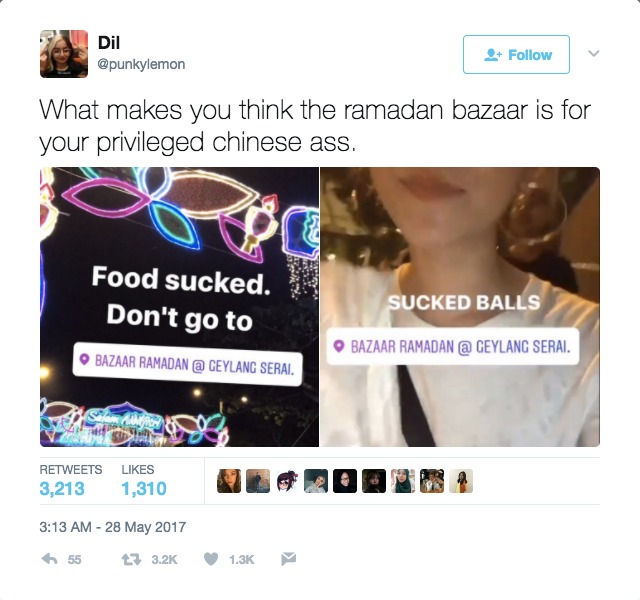 Image captured from @punkylemon’s Twitter profile
Image captured from @punkylemon’s Twitter profile

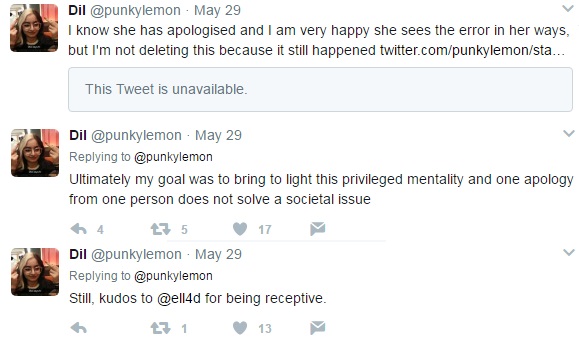 Images captured from @punkylemon’s Twitter profile
Images captured from @punkylemon’s Twitter profile
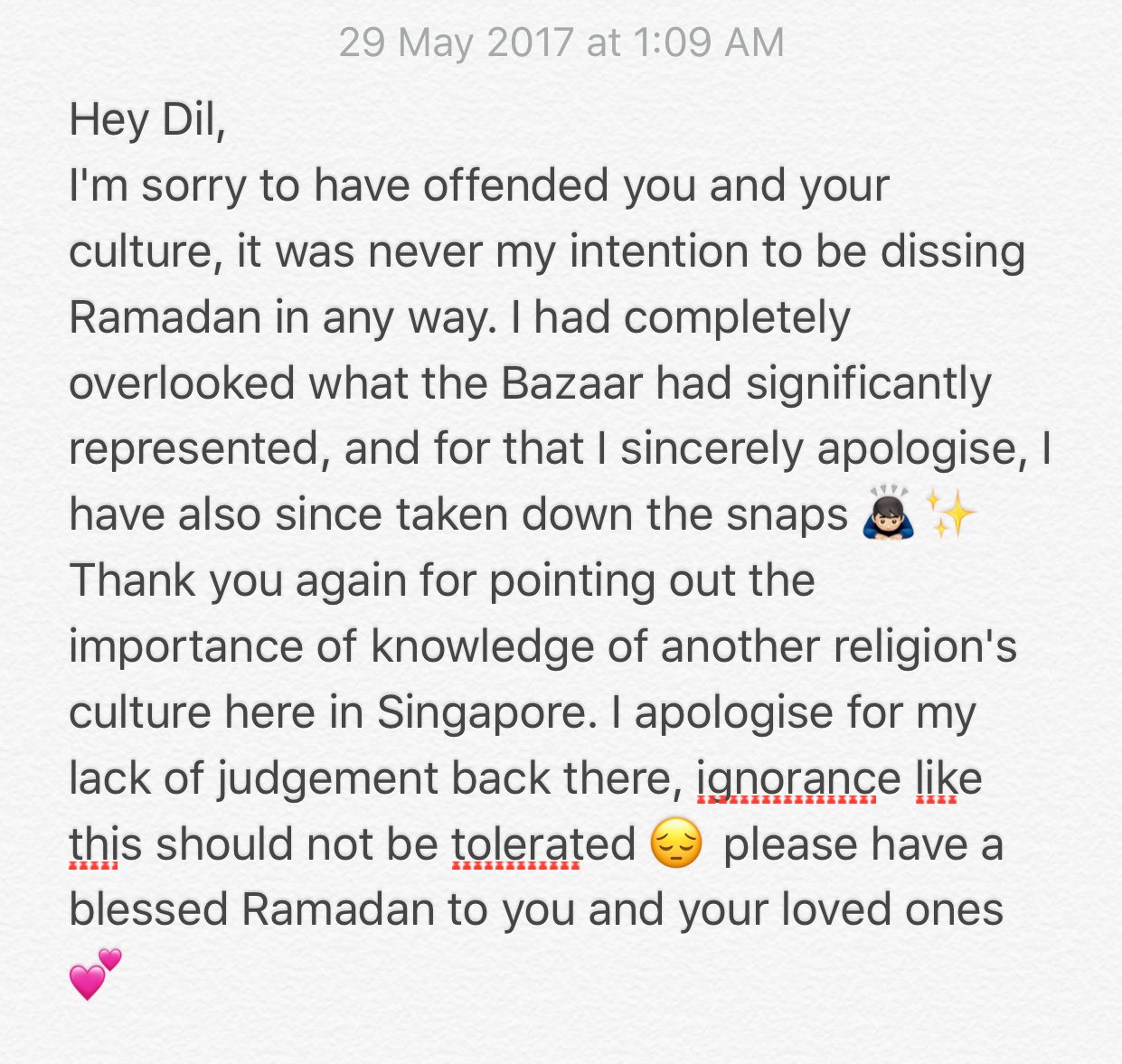 Image Credit: @ell4d’s Twitter profile
Image Credit: @ell4d’s Twitter profile
 Image captured from @asyikinyusoff’s Twitter profile
Image captured from @asyikinyusoff’s Twitter profile
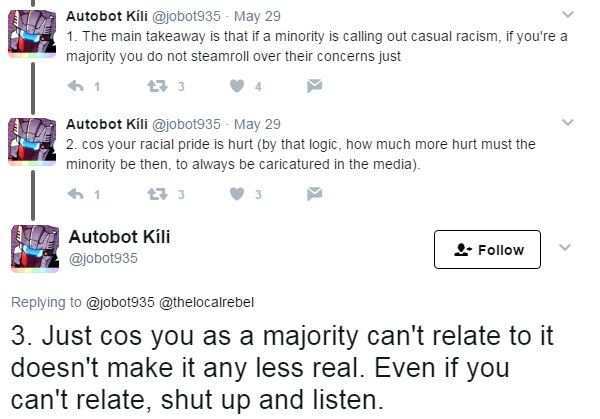 Image captured from @jobot935’s Twitter profile
Image captured from @jobot935’s Twitter profile
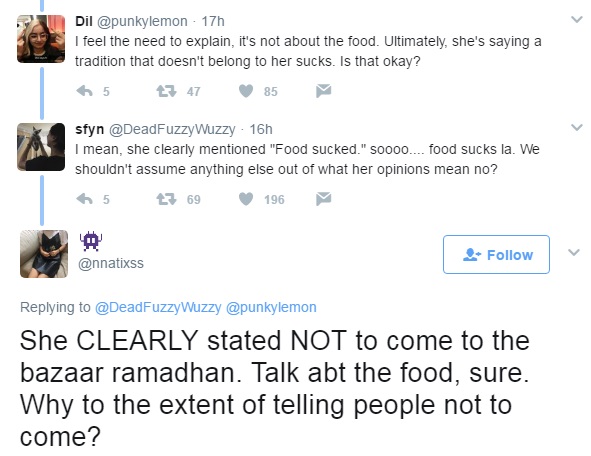 Image captured from @punkylemon’s Twitter profile
Image captured from @punkylemon’s Twitter profile
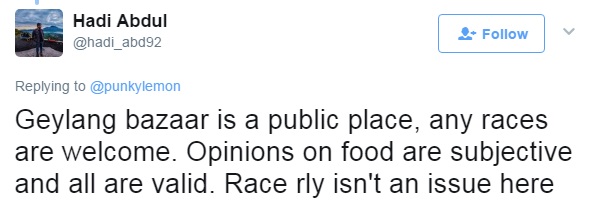 Image captured from @hadi_abd92’s Twitter profile
Image captured from @hadi_abd92’s Twitter profile
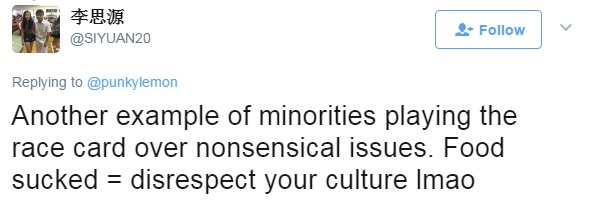
Image captured from @SIYUAN20’s Twitter profile
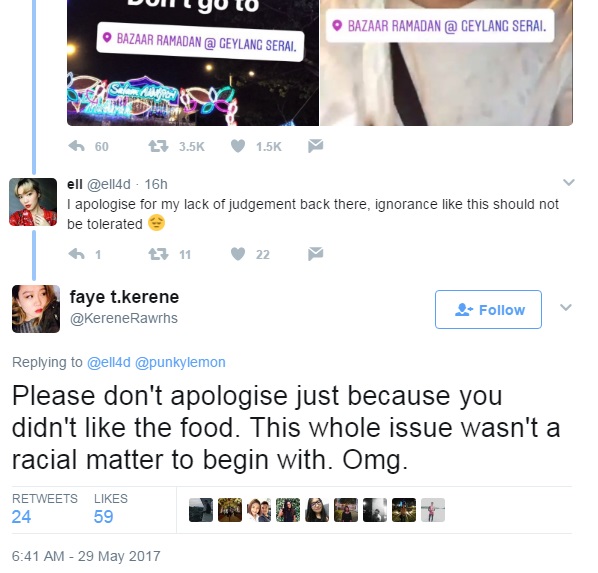 Image captured from @KereneRawrhs’s Twitter profile
Image captured from @KereneRawrhs’s Twitter profile
What’s wrong? What’s right?
Is the bazaar getting too commercialised for its own good? Now that more non-Muslims are flocking to the bazaar for the food and festival vibe, are Muslims bothered by it? As a Muslim in Singapore, how affected are you when non-Muslim Singaporeans make remarks like those mentioned above? Instead of deciding for ourselves, we asked our Muslim friends and here are their thoughts.Natasha: I think it’s insensitive to make such remarks but I try to think of it positively.
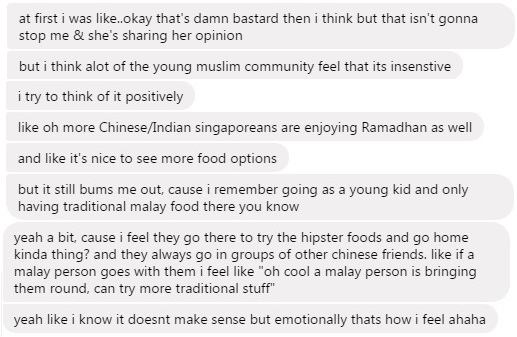
Ain: I do get annoyed, but when did we become so intolerant of one another?
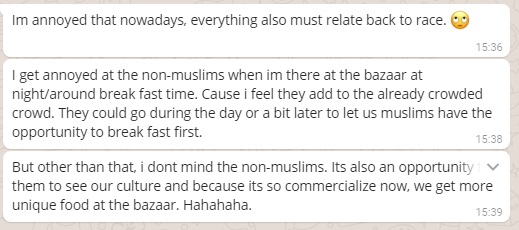
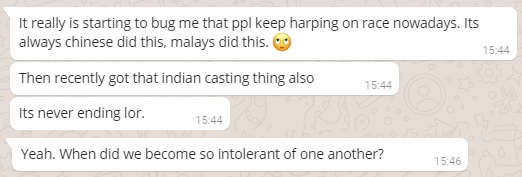
Maira: I don’t really care about such comments, but generally people should watch what they post.
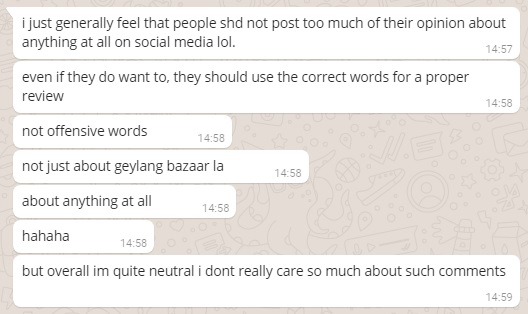
Siti: I’m not offended, everyone is entitled to their opinion.
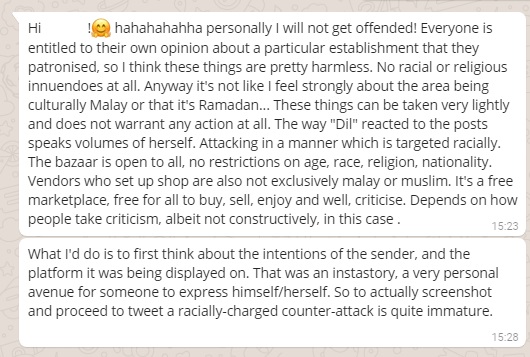 We all have our own personal beliefs, but in this racially hypersensitive time, we think all of us should be more aware of what we say to one another. What do you say?
Also read People Leave, But You Don't Have To Be The One Left Behind
(Top Image Credit: theodysseyonline)
We all have our own personal beliefs, but in this racially hypersensitive time, we think all of us should be more aware of what we say to one another. What do you say?
Also read People Leave, But You Don't Have To Be The One Left Behind
(Top Image Credit: theodysseyonline)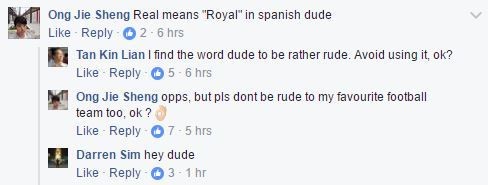
This Is Our Social Fabric, Mate
1. To “Bro” Is To Ask For A Favour
"Bro" is often followed by "can I get a discount?" after a deal is set. It is invoking the bro code at the last minute, which is strictly brohibited unless there has been a brolific and brogressive display of broactive behaviour. Get with the brogramme, guys.The writer suggests the word ‘bro’ is often used in the context of asking a favour. The truth is the word appears in far more varied contexts. We use ‘bro’ to start a conversation amicably with people. “Bro, long time no see!” creates a sense of friendship that's not strictly restricted to people blood-related to you. When you forget someone’s name, ‘bro’ is your savior. You don’t want to come across as indifferent. Be polite. When you are feeling paiseh or are talking about something that might be slightly embarrassing, ‘bro’ helps to tone it down. “Bro, your fly is open.” When you are giving advice or are trying to calm a friend down, ‘bro’ helps keep the conversation cordial and relaxed. “Eh bro, don’t angry lah!” versus “Oi, don’t angry lah!” While the first may be annoying, the second will surely fuel your rage.
2. Punctuating your sentences with "Bro"
Another thing about "bro" - it is the favourite of drive-time deejays. It is used in the sorts of ways - as punctuation, as a punchline, as a time-filler - that make me want to punch the car radio.One thing the writer does get right is that ‘bro’ is often used as a sort of punctuation. While ‘dude’ and ‘mate’ aren’t as common (who says ‘mate’ in Singapore, anyway?), ‘bro’ is so widely used in Singapore, it is a part of our social fabric. Just like we use Singlish terms such as ‘lah’ and ‘lor’ to express things no other words can, ‘bro’ has come to be a way we ‘prefix’ our conversations. What other word carries the same meaning and essence as 'bro'? None that I can think of.
3. To “Bro” is to give a false sense of closeness
For women, I've been told their equivalent of "mate" or "bro" is "babe". Like "bro", "babe" is meant to flatter, implying that the speaker has granted the other the wonderful gift of closeness, thus giving the user of the word the right to be a total donkey.What’s wrong with using ‘mate’, ‘bro’, or ‘babe’ to “grant the other party the wonderful gift of closeness”? Is it such a terrible thing to build rapport in conversations? Should we instead be keeping our conversational partners at arm's length? Last I checked, no one benefits from that. No one enjoys that interaction, no new relationships can bud from there... And really, that would be an awkward interaction.
